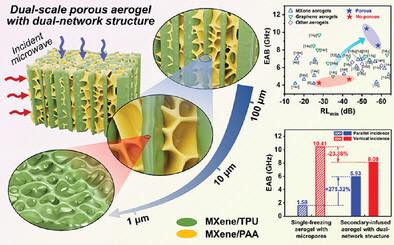Ultra-Bandwidth Microwave Absorption and Low Angle Sensitivity in Dual-Network Aerogels with Dual-Scale Pores
IF 13
2区 材料科学
Q1 CHEMISTRY, MULTIDISCIPLINARY
引用次数: 0
Abstract
Aerogels with porous structures offer an attractive approach to modulating electromagnetic parameters and enhancing electromagnetic wave (EMW) absorption performance. However, conventional aerogels are limited by their single-scale pore size and fixed orientation, which constrain their EMW absorption capabilities. This study introduces aerogels with dual-scale pores and dual-network structure constructed via constant-temperature freezing and secondary-infusion freezing method. Multiscale aerogels with both micrometer- and submillimeter-scale pores are constructed when the Ti3C2Tx MXene and thermoplastic polyurethane solution is frozen and dried at a specific temperature, leading to an ultra-wide effective absorption bandwidth (EAB) reaching 10.41 GHz in the vertical direction. Furthermore, to address the poor EMW absorption in the parallel direction, a secondary infusion freezing method is applied to form an aerogel with a dual-network structure, which forms reflective interfaces perpendicular to the incident EMW in various directions. This adjustment enhances the EAB in the parallel direction from 1.58 to 5.93 GHz, marking a 275.32% enhancement, while the EAB in the vertical incident direction reaches 8.08 GHz. This design strategy overcomes the limitations of structural scale and arrangement direction, enriching the attenuation mechanisms of the absorber, while effectively reducing sensitivity to the direction of incoming EMW, offering new insights for designing efficient EMW absorbers.

求助全文
约1分钟内获得全文
求助全文
来源期刊

Small
工程技术-材料科学:综合
CiteScore
17.70
自引率
3.80%
发文量
1830
审稿时长
2.1 months
期刊介绍:
Small serves as an exceptional platform for both experimental and theoretical studies in fundamental and applied interdisciplinary research at the nano- and microscale. The journal offers a compelling mix of peer-reviewed Research Articles, Reviews, Perspectives, and Comments.
With a remarkable 2022 Journal Impact Factor of 13.3 (Journal Citation Reports from Clarivate Analytics, 2023), Small remains among the top multidisciplinary journals, covering a wide range of topics at the interface of materials science, chemistry, physics, engineering, medicine, and biology.
Small's readership includes biochemists, biologists, biomedical scientists, chemists, engineers, information technologists, materials scientists, physicists, and theoreticians alike.
 求助内容:
求助内容: 应助结果提醒方式:
应助结果提醒方式:


